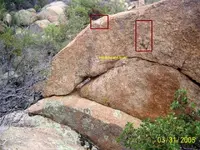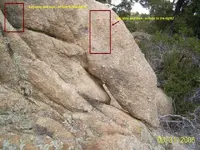HOLA amigos,
I was just going to make a "TAG" post, so I can follow this discussion easier but have to add my two shekels. This has been a very interesting thread! Thank you Rangler for the very kind words (viz ancient visitors to America) I can't claim credit for originating that idea though, even the Spanish conquistadors were convinced of it. Captain John Smith (of Pocahontas fame) wrote,
"
The Spanyards say that Hanno, a prince of Carthage, was the first and the next Christopher Columbus a Genoesiar, whom they sent to discover those unknown parts 1492."
(from The Historie of Virginia, can't recall the date of publication, 1624? Correction welcomed.)
...so I can't claim that I was the first to conclude that we had folks crossing the oceans long before Columbus.
I am certain that at least some of these ancient visitors buried or hid their treasures here in the Americas, as a very few have been found already. (In one case a new type of plow was being tried out that dug deeper than old models, hit a pocket with hundreds of silver Arabic coins was unearthed that predated Columbus - can't recall the date but it was either the late 1700's or early 1800's when this occurred.)
When we venture into the theory of Jesuits, Templars and others the evidence is murky. That Jesuit missionaries did found a number of missions and the smaller "visitas" in the southwest US/ northwest Mexico is a matter of record, but their involvement in mining activities is not well documented. Often what was a Spanish mine is thought to be a Jesuit mine by treasure hunters today, partly due to the habit of leaving crosses and other religious markers graven into the rock which is then seen as absolute proof of Jesuit involvement, when the fact is most Spanish owned and operated mines had crosses carved into the rocks around them, wooden crosses set up over the entrance etc not because they were Jesuit but because they wanted the protection of God when they were working underground. This is not to say that some Jesuits were NOT involved in mining, which was illegal under Spanish laws. Franciscans and Dominicans were also involved, and occasionally there were "turf" battles such as when the Franciscans founded missions in NE Arizona (even before the arrival of the Jesuits) which was within the Jesuits assigned regions, leading to complaints to the Crown and Pope etc. It is a complex story that only makes sense in parts!
That Templars could have known of America and had the technology to reach these lands seems possible, but finding traces of any Templars which may have visited these lands is quite a task. If they were coming to America, they would have likely done so with an eye to secrecy. It seems probable that they would not have publicized their voyages, and we are not likely to find documentation. I have to admit I am still very much on the fence with the Templars in America, though there are tantalizing bits of evidence as my amigo Rangler has pointed out in other threads. (eg Rosslyn, the strange stone tower in Rhode Island, the "gravestone" of Sir Gunn, etc) I suspect that Rangler has other evidence which might well seal the case, and I don't blame him for not posting it publicly - at least not yet.
I do
not find a lot to take issue with in the interpretation of treasure symbols, except that there is room for error. Some symbols used by those who hid treasures are (almost) identical with symbols used by Amerindians with very different purposes - such as the fairly common bird and turtle symbols. Even the heart symbol was occasionally used by Indios, so when these symbols are found it is profitable to take the circumstances into account before making any conclusions. Sometimes it is obvious - as when a turtle is found directly adjacent to other clearly Amerindian symbols, but other times we have to find other clues to either confirm or disprove that the symbol is treasure related.
I will add this, which was a little secret which took some time and effort for me to learn - that these treasure symbols can sometimes be laid out to deliberately throw off any treasure hunters. They will have markings that seem to indicate you should take so many steps, go to another marker, dig a certain depth etc when in reality it is the very
placement of the markers which locates the treasure cache. For example, four sets of complex and mysterious markers are found, with various symbols that seem to lead elsewhere - yet simply by using those four sites as "'posts" which should mark off a cross, then locate the spot where the two lines of sight cross where there is NO marker of any kind,
this is the spot where the treasure is buried. A flat stone or piece of metal may be buried in this exact spot (the center of the cross) at a shallow depth, directly over the treasure, which the people who buried the treasure could find again by simply pushing a sharp stick or probe into the dirt. To further protect the cache, the folks who buried it may well have also buried smaller, much less valuable "treasures" in places that would "fit" the false clues left on the marker stones, so that a treasure hunter following the false clues can then find the small treasure and quit looking. If this sounds terribly devious, just consider the folks who were hiding it, working illegally and always with the danger that the authorities might find out and try to locate their hidden treasures. These were educated people, as Rangler has mentioned - they were mining engineers, cartographers, even cosmographers and I would say they were very intelligent. Never underestimate the cunning of the folks who hid the treasures! The "cross" layout of marker clues is most common (just my own observation - no way I can prove it) but other layouts were also used, such as the Star of David or Solomon's Seal, though finding the site of the cache is then difficult.
Also - don't assume that finding a cross instantly means that Jesuits or even Christians made it - the cross was an important and powerful symbol LONG before Christ, (Phoenicians used the "long cross" for example) and even among some Amerindian tribes the cross was a powerful magic symbol. (Navajos used it, which was quite a shock to the Padres when they first encountered them.)
One last bit of advice for any neophyte treasure hunters, don't expect to find billboards for clues, most often the clues will be quite small and easily overlooked. If you find a huge marker, it is more likely than not a red herring intended to mislead a treasure hunter. Get a few books on Indian petroglyphs and pictograms, so as to help avoid mistaking Indian signs for treasure markers. The Indian petroglyphs are fascinating in themselves, and tell their own story.
Please do continue gentlemen, I have been enjoying this discussion very much!

your friend,
Roy ~ Oroblanco













